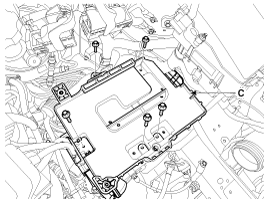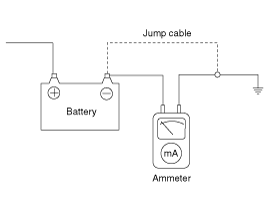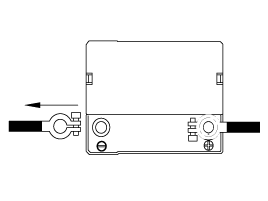Kia Cee'd: Charging System / Battery Repair procedures
| 1. |
Disconnect the battery (-)terminal (A) and then (+)terminal (B).

|
| 2. |
Remove the air duct and air cleaner assembly.
(Refer to Engine Mechanical System - "Air Cleaner")
|
| 3. |
Remove the battery mounting bracket (A) and the insulation pad (B),
and then remove the battery.

|
| 4. |
Disconnect the ECM connector (A), and then remove ECM (B) after removing
the bolts/nut.

|
| 5. |
Remove the battery tray (C) after removing the bolts.

|
| 1. |
Install in the reverse order of removal.
|
Battery (-)terminal installation:
4.0 ~ 6.0 N.m (0.4 ~ 0.6 kgf.m, 3.0 ~ 4.4 lb-ft)
Battery (+)terminal installation:
7.8 ~ 9.8 N.m (0.8 ~ 1.0 kgf.m, 5.8 ~ 7.2 lb-ft)
Battery mounting bracket and the insulation pad installation:
8.8 ~ 13.7 N.m (0.9 ~ 1.4 kgf.m, 6.5 ~ 10.1 Ib-ft)
ECM bracket installation bolts/nut:
9.8 ~ 11.8 N.m (1.0 ~ 1.2 kgf.m, 7.2 ~ 8.7 lb-ft)
Battery tray installation bolts:
8.8 ~ 13.7 N.m (0.9 ~ 1.4 kgf.m, 6.5 ~ 10.1 Ib-ft)
|
| •
|
When installing the battery, fix the mounting bracket
on the tray correctly.
|
|
| •
|
ISG (Idle stop & go) system equipped vehicle always
use the AGM battery only. If flooded battery has installed,
this can potentially lead to engine electrical trouble
or ISG system error.
|
| •
|
Replace same capacity of the AGM battery.
|
|
| •
|
Ensure an AGM battery is fitted.
|
| •
|
In all cases, an AGM battery must be installed and registered
in the vehicle for the ISG function to work perfectly.
|
| •
|
The vehicle with the new battery must be placed in the
ignition switch OFF and door closed, hood switch OFF
state for at least 4 hours.
|
| •
|
ISG system’s stabilization may take 4 hours after new
battery installation.
|
| •
|
ISG function is operates about 4 hours later and 2 times
cranking by user.
But first 25 times, the ISG function can operates regardless
of ISG system stability for ISG function operating check.
|
|
| •
|
Do not open the AGM battery.
The AGM battery must not be opened under any circumstances
as the introduction of oxygen from the air will cause
the battery to lose its chemical equilibrium and rendered
non-operational.
|
|
|
| Vehicle parasitic current
inspection |
| 1. |
Turn the all electric devices OFF, and then turn the ignition switch
OFF.
|
| 2. |
Close all doors except the engine hood, and then lock all doors.
| (1) |
Disconnect the hood switch connector.
|
| (3) |
Close the doors or remove the door switches.
|
|
| 3. |
Wait a few minutes until the vehicle’s electrical systems go to sleep
mode.
| •
|
For an accurate measurement of a vehicle parasitic current,
all electriacl systems should go to sleep mode. (It
takes at least one hour or at most one day.) However,
an approximate vehicle parasitic current can be measured
after 10~20 minutes.
|
|
|
| 4. |
Connect an ammeter in series between the battery (-) terminal and the
ground cable, and then disconnect the clamp from the battery (-) terminal
slowly.
| •
|
Be careful that the lead wires of an ammeter do not
come off from the battery (-) terminal and the ground
cable to prevent the battery from being reset. In case
the battery is reset, connect the battery cable again,
and then start the engine or turn the ignition switch
ON for more than 10 sec. Repeat the procedure from No.
1.
To prevent the battery from being reset during the inspection,
|
| a. |
Connect a jump cable between the battery (-) terminal
and the ground cable.
|
| b. |
Disconnect the ground cable from the battery (-) terminal.
|
| c. |
Connect an ammeter between the battery (-) terminal
and the ground cable.
|
| d. |
After disconnecting the jump cable, read the current
value of the ammeter.
|
|

|
| 5. |
Read the current value of the ammeter.
| • |
If the parasitic current is over the limit value, search for
abnormal circuit by removing a fuse one by one and checking
the parasitic current.
|
| • |
Reconnect the suspected parasitic current draw circuit fuse
only and search for suspected unit by removing a compoconnected
with the circuit one by one until the parasitic draw drops below
limit value.
|
|
Limit value (after 10~20 min.) : Below 50mA
|
|
| 1. |
Make sure the ignition switch and all accessories are in the OFF position.
|
| 2. |
Disconnect the battery cables (negative first).
|
| 3. |
Remove the battery from the vehicle.
| •
|
Care should be taken in the event the battery case is
cracked or leaking, to protect your skin from the electrolyte.
Heavy rubber gloves (not the household type) should
be wore when removing the battery.
|
|

|
| 4. |
Inspect the battery tray for damage caused by the loss of electrolyte.
If acid damage is present, it will be necessary to clean the area with
a solution of clean warm water and baking soda. Scrub the area with
a stiff brush and wipe off with a cloth moistened with baking soda and
water.
|
| 5. |
Clean the top of the battery with the same solution as described above.
|
| 6. |
Inspect the battery case and cover for cracks. If cracks are present,
the battery must be replaced.
|
| 7. |
Clean the battery posts with a suitable battery post tool.
|
| 8. |
Clean the inside surface of the terminal clamps with a suitable battery
cleaning tool. Replace damaged or frayed cables and broken terminal
clamps.
|
| 9. |
Install the battery in the vehicle.
|
| 10. |
Connect the cable terminals to the battery post, making sure tops of
the terminals are flush with the tops of the posts .
|
| 11. |
Tighten the terminal nuts securely.
|
| 12. |
Coat all connections with light mineral grease after tightening.
| •
|
When batteries are being charged, an explosive gas forms
beneath the cover of each cell. Do not smoke near batteries
being charged or which have recently been charged. Do
not break live circuit at the terminals of batteries
being charged.
A spark will occur when the circuit is broken. Keep
open flames away from battery.
|
|
|
Components
1. Battery insulation pad
2. Battery (Non-ISG Type)
3. Battery (ISG Type)
4. Battery tray
5. Battery mounting bracket
6. ECM
...
Other information:
Kia Cee'd JD Owners Manual: Larger children
Children who are too large for child
restraint systems should always occupy
the rear seat and use the available
lap/shoulder belts. The lap portion should
be fastened and snugged on the hips
and as low as possible. Check if the belt
fits periodically. A child's squirming could
put the ...
Kia Cee'd JD Owners Manual: Vehicles with smart key system
Whenever the engine start/stop button is
changed to the ON position, the immobilizer
system checks and verifies if the key
is valid or not.
If the key is valid, the engine will start.
If the key is invalid, the engine will not
start.
To deactivate the immobilizer system
Change the engin ...
 Battery Components and components location
Battery Components and components location Battery Troubleshooting
Battery Troubleshooting








